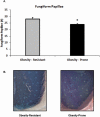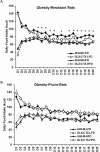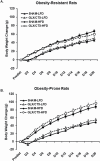Transection of Gustatory Nerves Differentially Affects Dietary Fat Intake in Obesity-Prone and Obesity-Resistant Rats
- PMID: 32766712
- PMCID: PMC7545249
- DOI: 10.1093/chemse/bjaa053
Transection of Gustatory Nerves Differentially Affects Dietary Fat Intake in Obesity-Prone and Obesity-Resistant Rats
Abstract
The current prevalence of obesity has been linked to the consumption of highly palatable foods and may be mediated by a dysregulated or hyposensitive orosensory perception of dietary fat, thereby contributing to the susceptibility to develop obesity. The goal of the current study was to investigate the role of lingual taste input in obesity-prone (OP, Osborne-Mendel) and obesity-resistant (OR, S5B/Pl) rats on the consumption of a high-fat diet (HFD). Density of fungiform papillae was assessed as a marker of general orosensory input. To determine if orosensory afferent input mediates dietary fat intake, surgical transection of the chorda tympani and glossopharyngeal nerves (GLX/CTX) was performed in OP and OR rats and HFD caloric intake and body weight were measured. Fungiform papillae density was lower in OP rats, compared with OR rats. GLX/CTX decreased orosensory input in both OP and OR rats, as measured by an increase in the intake of a bitter, quinine solution. Consumption of low-fat diet was not altered by GLX/CTX in OP and OR rats; however, GLX/CTX decreased HFD intake in OR, without altering HFD intake in OP rats. Overall, these data suggest that inhibition of orosensory input in OP rats do not decrease fat intake, thereby supporting that idea that hyposensitive and/or dysregulated orosensory perception of highly palatable foods contribute to the susceptibility to develop obesity.
Keywords: Osborne-Mendel; S5B/Pl; chorda tympani; glossopharyngeal nerve; high-fat diet.
© The Author(s) 2020. Published by Oxford University Press. All rights reserved. For permissions, please e-mail: journals.permissions@oup.com.
Figures




Similar articles
-
Lingual CD36 and nutritional status differentially regulate fat preference in obesity-prone and obesity-resistant rats.Physiol Behav. 2017 May 15;174:120-127. doi: 10.1016/j.physbeh.2017.03.015. Epub 2017 Mar 14. Physiol Behav. 2017. PMID: 28302572 Free PMC article.
-
Combined glossopharyngeal and chorda tympani nerve transection elevates quinine detection thresholds in rats (Rattus norvegicus).Behav Neurosci. 1996 Dec;110(6):1456-68. doi: 10.1037//0735-7044.110.6.1456. Behav Neurosci. 1996. PMID: 8986346
-
Sex differences in markers of metabolic syndrome and adipose tissue inflammation in obesity-prone, Osborne-Mendel and obesity-resistant, S5B/Pl rats.Life Sci. 2021 May 15;273:119290. doi: 10.1016/j.lfs.2021.119290. Epub 2021 Mar 1. Life Sci. 2021. PMID: 33662430 Free PMC article.
-
Fat and energy balance.Ann N Y Acad Sci. 1997 Sep 20;827:431-48. doi: 10.1111/j.1749-6632.1997.tb51853.x. Ann N Y Acad Sci. 1997. PMID: 9329773 Review.
-
Role of the Gustatory System in Fatty Acid Detection in Rats.In: Montmayeur JP, le Coutre J, editors. Fat Detection: Taste, Texture, and Post Ingestive Effects. Boca Raton (FL): CRC Press/Taylor & Francis; 2010. Chapter 4. In: Montmayeur JP, le Coutre J, editors. Fat Detection: Taste, Texture, and Post Ingestive Effects. Boca Raton (FL): CRC Press/Taylor & Francis; 2010. Chapter 4. PMID: 21452484 Free Books & Documents. Review.
Cited by
-
A systematic review of the biological mediators of fat taste and smell.Physiol Rev. 2023 Jan 1;103(1):855-918. doi: 10.1152/physrev.00061.2021. Epub 2022 Sep 15. Physiol Rev. 2023. PMID: 36409650 Free PMC article.
-
Orlistat mouth rinse: Using the tongue to deliver antiobesity medication in a double-blind randomized crossover pilot trial.Diabetes Obes Metab. 2023 Aug;25(8):2236-2242. doi: 10.1111/dom.15101. Epub 2023 May 3. Diabetes Obes Metab. 2023. PMID: 37132340 Free PMC article. Clinical Trial.
-
Lingual Taste Nerve Transection Alters Food Selection, Relative Macronutrient Intake, and Meal Patterns in Rats Consuming a Cafeteria Diet without Changing Total Energy Intake.eNeuro. 2024 Mar 7;11(3):ENEURO.0393-23.2024. doi: 10.1523/ENEURO.0393-23.2024. Print 2024 Mar. eNeuro. 2024. PMID: 38346902 Free PMC article.
References
-
- Bartoshuk LM, Catalanotto F, Hoffman H, Logan H, Snyder DJ. 2012. Taste damage (otitis media, tonsillectomy and head and neck cancer), oral sensations and BMI. Physiol Behav. 107(4):516–526. - PubMed
-
- Bartoshuk LM, Duffy VB, Miller IJ. 1994. PTC/PROP tasting: anatomy, psychophysics, and sex effects. Physiol Behav. 56(6):1165–1171. - PubMed
-
- Besnard P, Passilly-Degrace P, Khan NA. 2016. Taste of fat: a sixth taste modality? Physiol Rev. 96(1):151–176. - PubMed
Publication types
MeSH terms
Substances
Grants and funding
LinkOut - more resources
Full Text Sources
Medical
Miscellaneous

